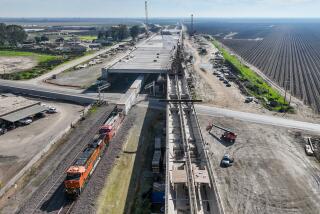A step forward for oil pipeline
WASHINGTON — The proposed Keystone XL oil pipeline from Canada to the Texas Gulf Coast would not have “significant impacts” on the environment, the State Department has concluded, removing a major barrier to construction of the $7-billion project.
The 1,700-mile-long pipeline has been a contentious issue in part because the oil would be extracted from oil sands in Alberta. Oil sands are an unconventional source of crude oil that needs to be mined from the earth, which environmentalists say would lead to the pollution of waterways and the destruction of vast stretches of Alberta’s forests.
The conclusion on the pipeline’s potential impact caps a final environmental statement the State Department published Friday as part of its review, required because the pipeline crosses a national border.
The final environmental impact statement is not the last word on the project. The State Department now needs to determine whether Keystone XL is “in the national interest,” which entails consideration of economic, diplomatic and energy security concerns, as well as public input from hearings to be held along the proposed pipeline corridor. A final decision on the permit is expected by year’s end.
The final assessment “is not a rubber stamp for the project,” said Kerri-Ann Jones, assistant secretary of State in the Bureau of Oceans and International Environmental and Scientific Affairs, in a telephone news conference Friday. “The permit is not approved until the rest of the process is completed.”
Still, Keystone XL’s supporters said the State Department decision catapulted the project toward eventual approval. “We believe that this is a major step forward,” said Michael Whatley, executive vice president for the Consumer Energy Alliance, an oil and gas advocacy group, “but clearly is not the last step.”
The final decision threatens to turn into a political liability for President Obama, whatever the outcome.
If the administration fails to issue a permit, it could bolster Republican and corporate claims that Obama has failed in job creation. Business has poured millions of dollars into information and lobbying campaigns asserting that the pipeline will create hundreds of thousands of construction jobs in the Midwest and secure oil from a friendly, democratic neighbor, with Canadian crude displacing oil from places such as Venezuela and Saudi Arabia.
If the administration does issue the permit, it risks alienating the environmental base that helped bring Obama to power in 2008 and whose energy and money the president desperately needs in 2012. This week, more than 300 activists have been arrested for protesting in front of the White House against the pipeline.
“It’s hard to point to any one issue as a litmus test,” said Sierra Club President Michael Brune, “but I have to say this will be the most important environmental decision the president will make between now and the election.”
Environmentalists also contend that tar sands extraction releases more greenhouse gases than pumping conventional crude oil would.
Midwesterners are also concerned that Keystone would pass through the Ogallala aquifer in Nebraska, the region’s main source of drinking water.
“I am tremendously disappointed that running the pipeline through the [aquifer] continues to be the State Department’s preferred route,” said Sen. Mike Johanns (R-Neb.). “The State Department is now one step away from giving the green light to a project that could have grave consequences for our state.”
The final environmental impact statement revises and builds on two more preliminary assessments that the State Department has issued over the last year, both of which were sharply criticized by the Environmental Protection Agency and environmental groups.
neela.banerjee @latimes.com
More to Read
Sign up for Essential California
The most important California stories and recommendations in your inbox every morning.
You may occasionally receive promotional content from the Los Angeles Times.










